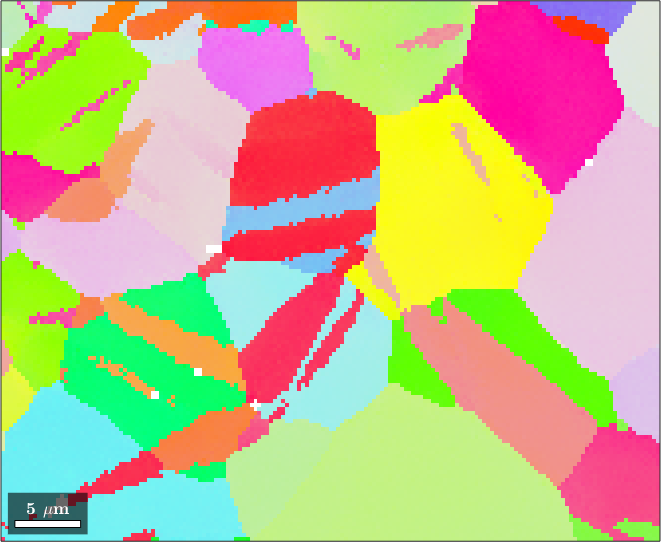extend EBSD data to an grid
Description
matrix shaped regular grid. No interpolation is done hereby. Grid points in the regular grid that do not have a correspondence in the regular grid are set to NaN. Having the EBSD data in matrix form has several advantages:
Syntax
[ebsdGrid,newId] = gridify(ebsd)
[ebsdGrid,newId] = gridify(ebsd,'unitCell',unitCell)Input
| ebsd | an EBSD data set with a non regular grid |
Output
| ebsd | EBSDsquare, EBSDhex data on a regular grid |
| newId | closest regular grid point for every non regular grid point |
Options
| extent | extend of gridded map |
| unitCell | unit cell of the gridded map |
Example
mtexdata twins
ebsdMg = ebsd('Magnesium').gridify
plot(ebsdMg, ebsdMg.orientations)ebsd = EBSD (y↑→x)
Phase Orientations Mineral Color Symmetry Crystal reference frame
0 46 (0.2%) notIndexed
1 22833 (100%) Magnesium LightSkyBlue 6/mmm X||a*, Y||b, Z||c*
Properties: bands, bc, bs, error, mad
Scan unit : um
X x Y x Z : [0, 50] x [0, 41] x [0, 0]
Normal vector: (0,0,1)
ebsdMg = EBSDsquare (y↑→x)
Phase Orientations Mineral Color Symmetry Crystal reference frame
1 22833 (100%) Magnesium LightSkyBlue 6/mmm X||a*, Y||b, Z||c*
Properties: bands, bc, bs, error, mad, oldId
Scan unit : um
X x Y x Z : [0, 50] x [0, 41] x [0, 0]
Normal vector: (0,0,1)
Square grid :137 x 167